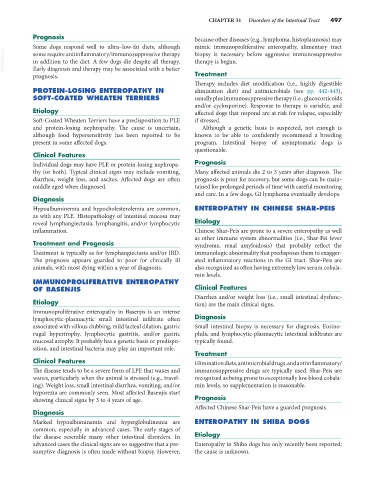Page 525 - Small Animal Internal Medicine, 6th Edition
P. 525
CHAPTER 31 Disorders of the Intestinal Tract 497
Prognosis because other diseases (e.g., lymphoma, histoplasmosis) may
Some dogs respond well to ultra–low-fat diets, although mimic immunoproliferative enteropathy, alimentary tract
VetBooks.ir some require antiinflammatory/immunosuppressive therapy biopsy is necessary before aggressive immunosuppressive
therapy is begun.
in addition to the diet. A few dogs die despite all therapy.
Early diagnosis and therapy may be associated with a better
prognosis. Treatment
Therapy includes diet modification (i.e., highly digestible
PROTEIN-LOSING ENTEROPATHY IN elimination diet) and antimicrobials (see pp. 442-443),
SOFT-COATED WHEATEN TERRIERS usually plus immunosuppressive therapy (i.e., glucocorticoids
and/or cyclosporine). Response to therapy is variable, and
Etiology affected dogs that respond are at risk for relapse, especially
Soft-Coated Wheaten Terriers have a predisposition to PLE if stressed.
and protein-losing nephropathy. The cause is uncertain, Although a genetic basis is suspected, not enough is
although food hypersensitivity has been reported to be known to be able to confidently recommend a breeding
present in some affected dogs. program. Intestinal biopsy of asymptomatic dogs is
questionable.
Clinical Features
Individual dogs may have PLE or protein-losing nephropa- Prognosis
thy (or both). Typical clinical signs may include vomiting, Many affected animals die 2 to 3 years after diagnosis. The
diarrhea, weight loss, and ascites. Affected dogs are often prognosis is poor for recovery, but some dogs can be main-
middle aged when diagnosed. tained for prolonged periods of time with careful monitoring
and care. In a few dogs, GI lymphoma eventually develops.
Diagnosis
Hypoalbuminemia and hypocholesterolemia are common, ENTEROPATHY IN CHINESE SHAR-PEIS
as with any PLE. Histopathology of intestinal mucosa may
reveal lymphangiectasia, lymphangitis, and/or lymphocytic Etiology
inflammation. Chinese Shar-Peis are prone to a severe enteropathy as well
as other immune system abnormalities (i.e., Shar-Pei fever
Treatment and Prognosis syndrome, renal amyloidosis) that probably reflect the
Treatment is typically as for lymphangiectasia and/or IBD. immunologic abnormality that predisposes them to exagger-
The prognosis appears guarded to poor for clinically ill ated inflammatory reactions in the GI tract. Shar-Peis are
animals, with most dying within a year of diagnosis. also recognized as often having extremely low serum cobala-
min levels.
IMMUNOPROLIFERATIVE ENTEROPATHY
OF BASENJIS Clinical Features
Diarrhea and/or weight loss (i.e., small intestinal dysfunc-
Etiology tion) are the main clinical signs.
Immunoproliferative enteropathy in Basenjis is an intense
lymphocytic-plasmacytic small intestinal infiltrate often Diagnosis
associated with villous clubbing, mild lacteal dilation, gastric Small intestinal biopsy is necessary for diagnosis. Eosino-
rugal hypertrophy, lymphocytic gastritis, and/or gastric philic and lymphocytic-plasmacytic intestinal infiltrates are
mucosal atrophy. It probably has a genetic basis or predispo- typically found.
sition, and intestinal bacteria may play an important role.
Treatment
Clinical Features Elimination diets, antimicrobial drugs, and antiinflammatory/
The disease tends to be a severe form of LPE that waxes and immunosuppressive drugs are typically used. Shar-Peis are
wanes, particularly when the animal is stressed (e.g., travel- recognized as being prone to exceptionally low blood cobala-
ing). Weight loss, small intestinal diarrhea, vomiting, and/or min levels, so supplementation is reasonable.
hyporexia are commonly seen. Most affected Basenjis start
showing clinical signs by 3 to 4 years of age. Prognosis
Affected Chinese Shar-Peis have a guarded prognosis.
Diagnosis
Marked hypoalbuminemia and hyperglobulinemia are ENTEROPATHY IN SHIBA DOGS
common, especially in advanced cases. The early stages of
the disease resemble many other intestinal disorders. In Etiology
advanced cases the clinical signs are so suggestive that a pre- Enteropathy in Shiba dogs has only recently been reported;
sumptive diagnosis is often made without biopsy. However, the cause is unknown.

